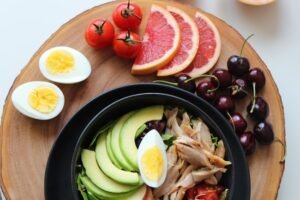It has to happen now and then. I take the palm of my hand to my forehead and say, “Why didn’t I do this sooner?” So, what did I do and what has this got to do with fertility foods?
Keeping a Fertility Foods Log
I was reading Fertility Foods by Jeremy Groll, and he casually wrote that one of his patients uses an online food log to help her keep track of what she’s really eating. With a daily count of calories in terms of carbs, protein and fat, she found it to be one of the most important parts of her low-carb fertility lifestyle.
Now this is exactly what I need to know.
I haven’t yet concluded what the optimal daily caloric distribution is for carbs, protein and fat, but I have absolutely no idea what I am getting right now.
First, I thought I’d figure out the optimal distributions and then find out what I’m eating. Bad idea. Why? Because although I don’t know the exact distributions yet, I have a very good idea.
Here’s what I Know About Balancing Fertility Foods
 Calories from protein should at least match the number of calories from carbs, and fat should be about half of that: so roughly 30-40% carbs, 30-40% protein, and 20-30% fat. These are just ranges, however, it still gives me a good idea of about where I want to be.
Calories from protein should at least match the number of calories from carbs, and fat should be about half of that: so roughly 30-40% carbs, 30-40% protein, and 20-30% fat. These are just ranges, however, it still gives me a good idea of about where I want to be.
So, I stopped reading mid-paragraph and made a bee line to my computer.
In less than ten minutes, I created an account on FitDay.com (the same website Dr. Groll’s patient used) and entered what I’d eaten for breakfast into my account – for free! Oh how I love the internet – you just need to know where to go.
My Results
My caloric distribution shocked me! I thought I wasn’t getting enough carbs because I was relying heavily on vegetables – eating only a small portion of whole grains each day.
What I found is that vegetables are a good source of carbs and my carb intake was about equal to my protein intake, which is good.
What isn’t good is that I was getting 52% of my daily calories from fat!
They were healthy fat sources like olive oil and lean meats, which are essential to the fertility diet, but over fifty percent is not a balanced diet.
Immediately, I adjusted my diet by cutting down the amount of olive oil I used in recipes and stopped eating a whole avocado every day. I then upped my vegetable and poultry intake to keep the calories the same.
It’s looking good. Not there yet, but my fat is down and varies somewhere between 35 to 45 percent. It’s progress.
And an awesome add on to this whole calorie counting log at fitDay.com is that it also gives you a complete breakdown of your daily intake of nutrients and compares them to the recommended daily allowances.
Sometimes, life is easy!
Fertility Foods to Consider
Fats for Fertility
- Organic free range eggs. They contain vitamins A, D, and E, all essential vitamins for fertility. Also Eicosapentaenoic Acid (EPA), Docosahexaenoic Acid (DHA) and choline.
- Eat oily fish such as wild salmon, mackerel, sardines and herring (2-3 portions a week). These foods contain essential fatty acids which can improve female fertility due to their anti-inflammatory properties. Fish oil is very beneficial for maintaining a healthy pregnancy and important for the baby’s brain development.
- Eat coconut oil and use it for cooking rather than other oils. It can withstand high heat without oxidizing. Coconut oil contains lauric acid providing anti-viral properties, and it is metabolized easily for energy.
- Eat nuts, seeds, avocado, and flax seed/flax oil.
- Include some saturated fat in your diet such as butter, full fat milk, cream and red meat.
Carbs for Fertility
- Starchy tubers- sweet potatoes, batata, jerusalem artichoke, cassava, tarot, and bamboo
- All fruits
- Brown rice
- Vegetables
Proteins for Fertility
- Eat organic grass fed or wild animal protein. Not all animal proteins are equal. grass fed animals offer much healthier nutrition as opposed to animals raised in intense agricultural settings where they are fed on grain and are full of hormones and antibiotics.
- Add a quality protein powder to your food. Whey protein or plant based protein powders.
- Organic free range eggs.
- Nuts, beans, chick peas, quinoa, lentils, pumpkin seeds.
- Organic oats,
- Cottage cheese, greek yoghurt
- All types of fish.
If you enjoyed reading my fertility blog, please write a comment here or bookmark it to a social bookmarking site by using the link below. Thanks!





